Alaska and Canada Reflections
We are in the fifth month of our trip, getting closer to home every week. We’re expecting to park Howie in our driveway somewhere in early October. But even though our journey is still on-going, I wanted to capture some thoughts about the far-northern portion while still fresh in my mind. These “take-aways” are largely keepsakes for my journal/blog, but also to share with my readers the goods, bads, and even an ugly or two about where we’ve been and what we’ve experienced. Think of this post as a kind of anthology of epilogs. Many more words than pictures this time – – –
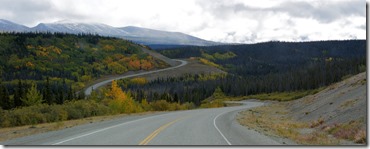
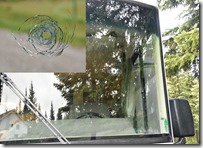
Highways – No worries. Well, with one exception: if you’re a driver who never wants his tires to touch dirt, Stay out. Canadian highways are excellent, better in many respects than many of the U.S. highways we’ve traveled. BUT – – – to keep them excellent, they are rigorously maintained. And the only time to maintain them is June-September, while we are all traveling on them. Highway construction is endemic, as are lengthy delays (half-hour), long stretches of dirty, dusty or muddy, gravel roads (20 miles or more in some spots). Canadians and Alaskans are very accustomed to this, casually so in fact, to the extent that they are not particularly generous with warning signs. We’ve many times come around a curve and found a flag-person standing there with STOP displayed a few yards in front of our nose. The trusting souls didn’t seem to know that I was just looking at my GPS, sipping some coffee, or looking at the scenery (maybe all three simultaneously). Also take carful note: warning flags used to indicate road damage are located AT THE DAMAGE. That’s where your suspension will be ripped off if you don’t slow down. No advanced warning in either case. Drive slow and scan the road ahead. But do take comfort that most Canadian and Alaskan highways are paved and paved well – – – except in some spots.
Yes, do be ready for windshield damage. And it can come at the oddest times. Our huge smash (driver’s side) occurred not on a grungy gravel road, but on Trans-Canada 16 in a rainstorm just outside Prince George. But we had other small dings on the gravel stretches, always due to passing trucks. We learned to go slow, and steer for the side of the road. But in some areas, the road edges are treacherous; a wheel off the edge can produce a roll-over.
Also be ready for rock-chip tire flats. Many folks in the know carried a variety of plug kits and a compressor. Others carried a spare (or two), especially if they ran unusual-size tires. I am thinking that it would be possible to survive without the spare (many RV’s don’t have one) with good plugging skills and an air source. That’s probably how we’ll travel the next time. I’m not sure I could manage changing a 130-pound tire on Howie anyway; plugging can be done without removing the tire. For Ralph, our 4×4, we go a LONG way from any help; a spare is mandatory, but probably not for Howie. This trip, Ralph got the flat, but it was a slow leak. Instead of plugging it with one of our three kits, we ended up having it professionally fixed. But we knew we could have taken care of it ourselves, and our air compressor kept it at operating pressure until we got to a shop.
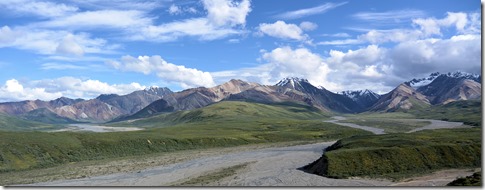 Mind-numbingly vast and wild – British Columbia is about the size of all four of our western U.S. states – with less than 1/20 of the population. The entire Yukon territory is about half this size, but its population is that of a medium town, 50,000. Alaska is even bigger than B.C.; it has 730,000 people, but most of them are compressed into Anchorage and Fairbanks. In short, the North is vast, and it’s wild, almost beyond description. There are not hundreds, but thousands of miles of roads with no fences, few spur roads, few towns, and no cities whatsoever. And beyond the roads, there is twice as much land again, stretching out past your imagination. The single most powerful, nearly overwhelming impression of the North is its size and raw nature.
Mind-numbingly vast and wild – British Columbia is about the size of all four of our western U.S. states – with less than 1/20 of the population. The entire Yukon territory is about half this size, but its population is that of a medium town, 50,000. Alaska is even bigger than B.C.; it has 730,000 people, but most of them are compressed into Anchorage and Fairbanks. In short, the North is vast, and it’s wild, almost beyond description. There are not hundreds, but thousands of miles of roads with no fences, few spur roads, few towns, and no cities whatsoever. And beyond the roads, there is twice as much land again, stretching out past your imagination. The single most powerful, nearly overwhelming impression of the North is its size and raw nature.
In the U.S., most of the wild country is served up in small packets of wilderness areas. The less-wild sections are typically national forest areas, criss-crossed by lumber roads, mining roads, hunting roads, and so forth. It’s fairly simple to get very close to, or into, most of the U.S. wild country, because there are some sort of roads within 20-30 miles of nearly all of it. Call it “windshield wild”. NOT SO up north. Spindly little highways scratch their way across massive areas of land that have no other access whatsoever, saving non-wheeled stuff like snowmobiles, aircraft, and boats. It’s just not simple, or in many cases possible, to simply Jeep into a wild area.
To get to the wild stuff up North, you generally need to walk, fly, or boat. In some areas, there is one other exception, the quad. These little four-wheelers are ubiquitous, to the extent that many highways can be found with long stretches of sidewalk-looking tracks made by and used by quads. These are the summer equivalent of snowmobiles, and while they’re not quite as versatile as their winter brothers, they do a good job when there’s no snow. We passed up a chance to quad into some Kenai back-country. Next time we’ll definitely do some of this kind of exploring.
Reservations – Almost never. We purposefully traveled without plans and just a general direction and highway in mind. From May through September, we made reservations only twice: Denali (necessary to get into the park to camp), and Jasper National Park (to be sure we had a camp site near friends we’d be meeting). We set out this way intentionally, and we knew we might have problems finding a site on any given night. But we never did. And many of the sites we did find were absolute jewels, which we could not possibly have known in advance.
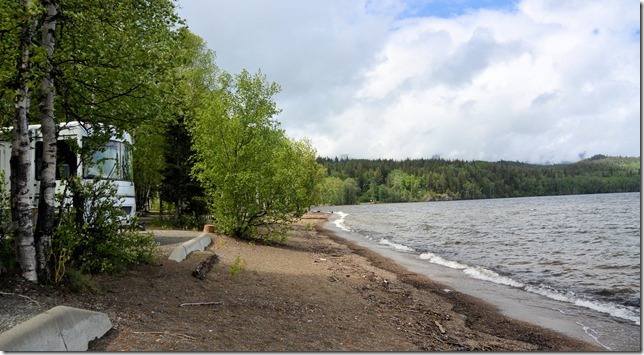
We did have to make reservations for tours and such; these are rarely available on a walk-in basis. But even the best tours we took, like Lu-Lu Belle and glacier kayaking, were only one or two-day advance bookings.
Camping and Fees – RV-friendly campgrounds are everywhere. I don’t know how they all stay in business. Although we lean toward the “government” campgrounds for their lower fees and widely-spaced sites, we did stay at regular private RV parks, which tend toward the “parking lot” design with a few exceptions. Fees for private parks were always in the CA$30-40 range, and since we are fully self-contained, we usually don’t like to pay for hookups that we don’t need. But they are there, all along most highways, and there seemed always to be a camp ready for us when we wanted to stop.
Alberta is, paradoxically, the cheapest and most expensive place to camp on our travels. We didn’t sample the private parks, but the provincial parks average CA$26 a night, compared to CA$20 for B.C. and CA$12 (!) for Yukon. Alaska was in the US$18 range. But Alberta is the very first place in this four-month trip that we have seen mapped and placarded free-camping spots. Boondocking, wild-camping, call it what you will, with our southwestern U.S. experience on BLM lands, we’re very accustomed to not paying for our camp sites. It’s been a constant frustration in Canada and Alaska to be un-familiar with “public” lands and be regularly limited to paid camp sites.
So we were delighted with Alberta’s “user-maintained” areas, several of which were along the Highway 40 route (see previous post). And we were pleased again while traveling the Icefields Parkway (Jasper-to-Banff), to find large recreation areas along Highway 11 to the east, with spacious camping, no facilities, no fees, and very few neighbors. One night, we camped, sheerly by luck and last-minute referral, at the southern tip of Abraham Lake. The nearest camper was about 200 yards away. With 180-degree views of the shoreline, lake, and surrounding mountains, we had a grand time. One of our all-time best camps, for free.
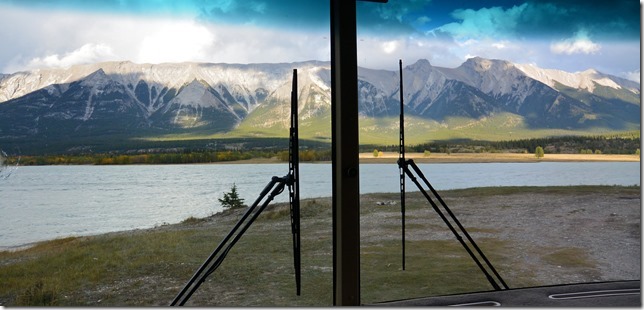
Boondocking – We are died-in-the-wool boondockers. We love nothing better than to pull off the highway on some un-named dirt road, find a flat spot and park for the night (or nights). Near a stream or lake is even better. Before we left, we tried to research boondocking in Canada, with mixed results. Some folks we asked simply didn’t understand the concept at all. Others said “Sure, just pull off and park, nobody will bother you”. VERY long story short, we did almost NO boondocking in four months’ travel (but see previous notes for Alberta). There were two primary reasons: 1. It’s really difficult to know in advance where we could go, what wasn’t private, and what wouldn’t get big Howie stuck. The path of least resistance was always a known-good campground that we could get in and out of without a tow truck. And many, many campgrounds we stayed at were prime territory, much nicer surrounds than anything we might have discovered on our own. 2. It would have been possible to park Howie and take Ralph out scouting, to find a boondock site. In fact, we considered this many times, but we always came to the conclusion that a fast easy designated camp was better (at that moment) than a long exploratory drive that might produce only a gravel pad somewhere just off the road. For future visits, we will plan to dedicate much more time to research and exploration; we will also plan to stay at one site for a length of time, which will help justify the effort to discover it. So the question “Is boondocking ‘allowed’ in Canada” is certainly YES. It’s just not easy or necessarily desirable, depending on time and circumstances.
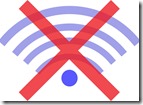
Wifi – We did a lot of research before we left for Canada, and were assured that wifi was ubiquitous. In fact, Canada is a wifi desert, bereft of any decent Internet connection except in the larger towns. Wifi at RV parks is expensive, slow, and metered either by speed, data, time, or a combination. Many places have log-on time limits, even the libraries. So we couldn’t just check our email in the morning for a few minutes and again in the afternoon – it was a one-time per day affair. You can read more about how we dealt with this in a longer post HERE. Eventually, we acquired a hotspot, but even that device was only useful much further south than the bulk of our travels took us. Again, 3G and (hah!) 4G can be found only in larger population centers.
Some folks may regard no-connection as a plus, and good for them. For us, checking up on email, weather, a bit of news, and any pressing issues from home – we prefer a connection every couple of days. A decent one. We always had to work for it.
Good food – We’ve been increasingly health-conscious over the last decade or so, gradually learning more and more about medical care and – most importantly — how to feed ourselves properly. This has resulted in a conspicuous approach to the inspection of restaurant menus (and mostly eating at home), and careful selection of grocery goods. Sadly, in much of northwestern Canada, quality grocery goods are very hard to find. We were often forced to purchase clearly wilted, oxidized greens simply because that’s all that was to be had. At premium prices too. Luckily, Karin had gotten skilled at growing sprouts, and we always had a fresh supply of these tasty treats to brighten our meals.
Northwestern Canada seems to be <slightly> aware of things like Organic foods, grass-fed beef, and such. But it’s not generally available. Whitehorse was large enough to have a few supplies, but Watson Lake? Stewart? Forget it.
Restaurants and cafes everywhere, including the U.S., generally don’t understand the meaning of nutrition. “Home Cooked” meals usually means meat and potatoes, and we avoid these places. Vegetables, if available, routinely over-boiled and tasteless. In fact, we’ve become so particular about the quality of our food that we rarely eat out anymore. So we’re not a good resource for this type of information. Suffice it to say, there are ample sources for hamburgers, ice cream, fish-and-chips, and classic “home cooked” fare. It just doesn’t suit us. When we do take the trouble to find a good (for us) eatery, it’s a rare treat. Dawson Creek’s Brown’s Social House was one, exceptionally nice and even a gluten-free menu.
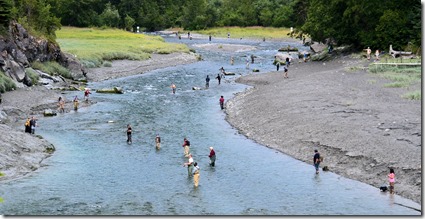 Crowds, crowds, crowds – Mostly in Alaska, but occasionally in Canada, we’d run into FAR more people than we had ever expected to encounter. In Alaska, it’s a combination of tourist season and salmon season. In Canada, it’s just tourist season. The problem is that comfortable travel can only occur (generally) from June to September. That means that a whole year’s visitation has to happen in just four months. Add the absolute frenzy of salmon runs in Alaska and you have near pandemonium.
Crowds, crowds, crowds – Mostly in Alaska, but occasionally in Canada, we’d run into FAR more people than we had ever expected to encounter. In Alaska, it’s a combination of tourist season and salmon season. In Canada, it’s just tourist season. The problem is that comfortable travel can only occur (generally) from June to September. That means that a whole year’s visitation has to happen in just four months. Add the absolute frenzy of salmon runs in Alaska and you have near pandemonium.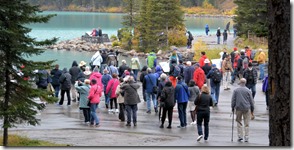
Part of our personal issue was that we generally don’t travel during the busy summer months, preferring the “shoulder” Spring and Fall seasons. But up North, there’s no choice, so not only did we have to travel during the peak months, but we had to travel to premier destinations that everyone in the world travels to – at the same time they did. We were routinely met with nearly-full campgrounds (really full only once or twice). And there was always another alternative or overflow area, so it was never necessary to make big changes in plans. But it was not as relaxing as our other Spring/Fall travels have been. What’s the most full? The big parks of course. Denali, Jasper. Gorgeous places, but everyone wants to see them.
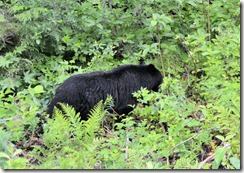 Wildlife – I can only say that we must have had our expectations too high. We did see some bears and moose on occasion along the road. But in 13,000 miles of combined driving (Howie and Ralph), we can count the sightings of large animals on two hands. We drove many hundreds of miles with no animal sightings at all, none. The most we ever saw were several black-bear sightings along the Cassiar highway in B.C. The most thrilling animals we saw were definitely the young sparring grizzlies at Wolverine Creek (see my post HERE), but we had to fly out to see them. We saw grizzlies and caribou in Denali, but not from our own vehicles. In short, we learned that we would be very lucky to see anything along the roadsides. This attitude was borne out by many small episodes where other people, including locals, would be excited about seeing a wolf, a moose, a bear, along some highway or another. It’s just plain unusual, and so we learned not to expect too much. If you’ve read through my posts, you will have seen everything exciting that we saw in terms of wild animals, because I shared all of it – and it’s just not a lot for 13,000 miles of driving and looking. So how to see them? You really have to go to where they’re known to be (like Wolverine Creek). And even then, it’s not sure-fire. We went to the Russian River, a known bear/salmon feeding area, during the peak of salmon season. We saw shoals of salmon and dozens of eaten salmon carcasses. But no bears, that day.
Wildlife – I can only say that we must have had our expectations too high. We did see some bears and moose on occasion along the road. But in 13,000 miles of combined driving (Howie and Ralph), we can count the sightings of large animals on two hands. We drove many hundreds of miles with no animal sightings at all, none. The most we ever saw were several black-bear sightings along the Cassiar highway in B.C. The most thrilling animals we saw were definitely the young sparring grizzlies at Wolverine Creek (see my post HERE), but we had to fly out to see them. We saw grizzlies and caribou in Denali, but not from our own vehicles. In short, we learned that we would be very lucky to see anything along the roadsides. This attitude was borne out by many small episodes where other people, including locals, would be excited about seeing a wolf, a moose, a bear, along some highway or another. It’s just plain unusual, and so we learned not to expect too much. If you’ve read through my posts, you will have seen everything exciting that we saw in terms of wild animals, because I shared all of it – and it’s just not a lot for 13,000 miles of driving and looking. So how to see them? You really have to go to where they’re known to be (like Wolverine Creek). And even then, it’s not sure-fire. We went to the Russian River, a known bear/salmon feeding area, during the peak of salmon season. We saw shoals of salmon and dozens of eaten salmon carcasses. But no bears, that day.
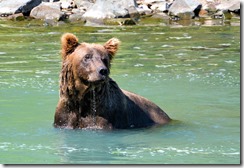 Bears – This is a universal topic in the North, especially among tourists. Prior to our trip, I had some serious concerns about our safety when camping or hiking up North. I read everything I could find on traveling in bear country, and talked to everyone who seemed to know anything about bears and where we’d find them and how to deal with them. I’ve talked to a dozen people who know folks who have been attacked and mauled, or know of victims. The short story is that more people are injured or killed by moose than by bears. It’s highly unlikely that a hiker will see a bear, much less be molested by one – but it does happen, and the data is clear. There are two ingredients which predominate all the stories I’ve heard: food, and sows with cubs. Bears spend the whole summer trying to get fat for the winter. Easy food draws them like ants to a picnic. Tourists and campers repeatedly break good bear-country behavior by leaving food out, or even actually “baiting” the bears by feeding them. When a bear gets accustomed (very quickly) to such easy food, he’s called “habituated”. He becomes a camp pest or a trail nuisance/danger, and he’s typically removed (killed). It’s far too expensive to trap and relocate bears; manpower doesn’t support it. Besides, they often wander back.
Bears – This is a universal topic in the North, especially among tourists. Prior to our trip, I had some serious concerns about our safety when camping or hiking up North. I read everything I could find on traveling in bear country, and talked to everyone who seemed to know anything about bears and where we’d find them and how to deal with them. I’ve talked to a dozen people who know folks who have been attacked and mauled, or know of victims. The short story is that more people are injured or killed by moose than by bears. It’s highly unlikely that a hiker will see a bear, much less be molested by one – but it does happen, and the data is clear. There are two ingredients which predominate all the stories I’ve heard: food, and sows with cubs. Bears spend the whole summer trying to get fat for the winter. Easy food draws them like ants to a picnic. Tourists and campers repeatedly break good bear-country behavior by leaving food out, or even actually “baiting” the bears by feeding them. When a bear gets accustomed (very quickly) to such easy food, he’s called “habituated”. He becomes a camp pest or a trail nuisance/danger, and he’s typically removed (killed). It’s far too expensive to trap and relocate bears; manpower doesn’t support it. Besides, they often wander back.
Sows with cubs is something else. This is the real wild card of bear country, because the sow will immediately attack anything she sees as a threat to her cubs. Surprising a sow/cub combination, or getting in between them, is almost a sure-fire recipe for a mauling. The remedy is simple – be very noisy on the trail. Bells? EVERYBODY said they were ineffective and an annoyance only to people. TALK, laugh, even sing. Shuffle and rustle and travel in groups. That’s the way to stay safest in bear country. Don’t surprise them and they won’t surprise you.
So after all this time and never an encounter, I’m hardly complacent. I hike with bear spray, I don’t leave my BBQ out on the table, and I don’t walk quietly in bear country. But I also worry a lot less than I did before, and I enjoy the woods more.
Friendly folks – Without a doubt, the Canadians were among the friendliest people we’ve met in our travels. They were, as a class, always ready for a conversation and to share what they knew, who they were, and how their lives were. We never felt treated like “marks”, as tourists are too often seen. We never even felt treated like foreigners, even though we (officially) were. It’s certainly the most comfortable I’ve ever been in any foreign country. (Yeah, I know Canada is not that “foreign”, but it’s still not my home-USA.)
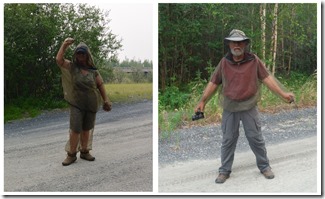 Bugs – The mosquitoes of Alaska and Canada are legendary, and with good reason. On the tundra, going up to the Arctic Ocean, we had a night that we’ll remember for the rest of our lives.
Bugs – The mosquitoes of Alaska and Canada are legendary, and with good reason. On the tundra, going up to the Arctic Ocean, we had a night that we’ll remember for the rest of our lives.
In-season, mosquitoes have been known to kill caribou and even horses. As our luck would have it, mosquito season ended early in 2015. By the end of June, we hardly ever saw another of the monsters in Alaska or Canada. But talking to locals, we found that this was a very rare case. We used a combination of “natural” repellents (we don’t care to use DEET), and netting-clothing. These worked okay, but not perfectly – we still got some bites. We also scoured the RV for “bug leaks” and plugged them up some way or another.
A fantastic tool for dealing with mosquitoes is the “bug racket”, a small-tennis-racket-looking thing. We thought this was just a toy, but it literally sweeps the mozzies from the air with a high-voltage screen. Very quick way to clean up the RV, and it avoids leaving the bloody red spots when you simply swat them.
We personally didn’t have much trouble with biting flies or midges (no-see-ums) – but we talked to people who had been driven mad by both.
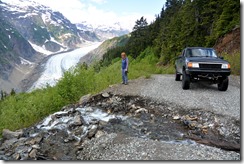 Driving Ralph – My 1996 Ford Ranger will be 20 years old next year. Not much for a person, but getting kind of old and grizzled for a truck. Ralph has an oxidized paint job, six inches of suspension lift, 31-inch knobby tires, and a bunch of gnarly hardware up front that is only used for towing, but looks somehow a little menacing. His underbody is perched 18” above the ground’s mud and rocks, and sometimes you can see more daylight under Ralph than above him. In short, Ralph looks a lot like the local folks’ trucks. We were always getting waves and nods and “howdy” gestures from the locals whenever we were exploring in Ralph. It helped some that he was usually so dirty you couldn’t see his incriminating California rear license plate (and I long since took off the front one). And then, with my beard and longish hair, pulling up in Ralph and walking into a store, most folks assumed I was a local. I’d get driving instructions like “It’s across from the gray cliff just before the turnstile”. Then I’d have to explain my lower-48 origins. I heard more than once, “Oh, I thought you were from around here”.
Driving Ralph – My 1996 Ford Ranger will be 20 years old next year. Not much for a person, but getting kind of old and grizzled for a truck. Ralph has an oxidized paint job, six inches of suspension lift, 31-inch knobby tires, and a bunch of gnarly hardware up front that is only used for towing, but looks somehow a little menacing. His underbody is perched 18” above the ground’s mud and rocks, and sometimes you can see more daylight under Ralph than above him. In short, Ralph looks a lot like the local folks’ trucks. We were always getting waves and nods and “howdy” gestures from the locals whenever we were exploring in Ralph. It helped some that he was usually so dirty you couldn’t see his incriminating California rear license plate (and I long since took off the front one). And then, with my beard and longish hair, pulling up in Ralph and walking into a store, most folks assumed I was a local. I’d get driving instructions like “It’s across from the gray cliff just before the turnstile”. Then I’d have to explain my lower-48 origins. I heard more than once, “Oh, I thought you were from around here”.
Personal changes — At several different times during our wanderings, we paused to consider what we were learning, and how the journey had changed us. Aside from simple things like being less fearful of a bear attack, there have been some deeper effects. Confidence is one – we’ve suffered bad weather, mechanical breakdowns, stuffed-full campgrounds, poor maps, and (worst of all) people who’ve run their generators all night in the campsite next to us. We’ve come through it all healthy, happy, and secure in the knowledge that we can deal with just about everything. We also know that we can live indefinitely in Howie, and with each other, and be very content with it.
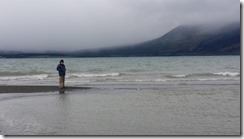 See and return – I stood at the wild edge of wild Kluane Lake in the wild west of the Yukon Territory. The weather had been cold, blustery, low clouds and snow pellets all day. All the surrounding peaks had fresh mantles of snow. Typical August weather – for the Yukon. We’d spent the day exploring, and learned a little about the highway part of the lake’s shore. But we’d learned even more about all the things we would not be able to go see, go hike to, or simply view in good weather. We had to be moving on. No trip lasts forever, and this trip had always been gated by the doors of winter. Howie, our RV, would solidify and crack his water pipes if we kept him out in freezing weather, so we needed to run for the border, and southward, before then. Repeatedly, we reflected on the vast nature of what we came to see, and how little time we have on this Earth to be able to see and appreciate it. Will we ever have visited the North enough to not want to return? Hardly.
See and return – I stood at the wild edge of wild Kluane Lake in the wild west of the Yukon Territory. The weather had been cold, blustery, low clouds and snow pellets all day. All the surrounding peaks had fresh mantles of snow. Typical August weather – for the Yukon. We’d spent the day exploring, and learned a little about the highway part of the lake’s shore. But we’d learned even more about all the things we would not be able to go see, go hike to, or simply view in good weather. We had to be moving on. No trip lasts forever, and this trip had always been gated by the doors of winter. Howie, our RV, would solidify and crack his water pipes if we kept him out in freezing weather, so we needed to run for the border, and southward, before then. Repeatedly, we reflected on the vast nature of what we came to see, and how little time we have on this Earth to be able to see and appreciate it. Will we ever have visited the North enough to not want to return? Hardly.
Next Time – So, having done our go-nearly-everywhere four-month recon, what would we do the next time up North? For sure, we would target some regions and spend far more time in one locale. We would do a lot more hiking, focusing on day trips into the back country. We might take a fly-in trip to some really remote place accessible only by air. Essentially, more time being there, less time driving there. And also for sure, we’ll have an armload (figuratively speaking) of back-country maps showing what (if any) roads we can use to explore. Regions? Southern Yukon, northern B.C., and the Wrangell-St. Elias Park/Reserve in Alaska. Maybe Denali again. Possibly the Dalton Highway to the top.
And then, of course, there’s the entire unexplored (by us) Inside Passage.
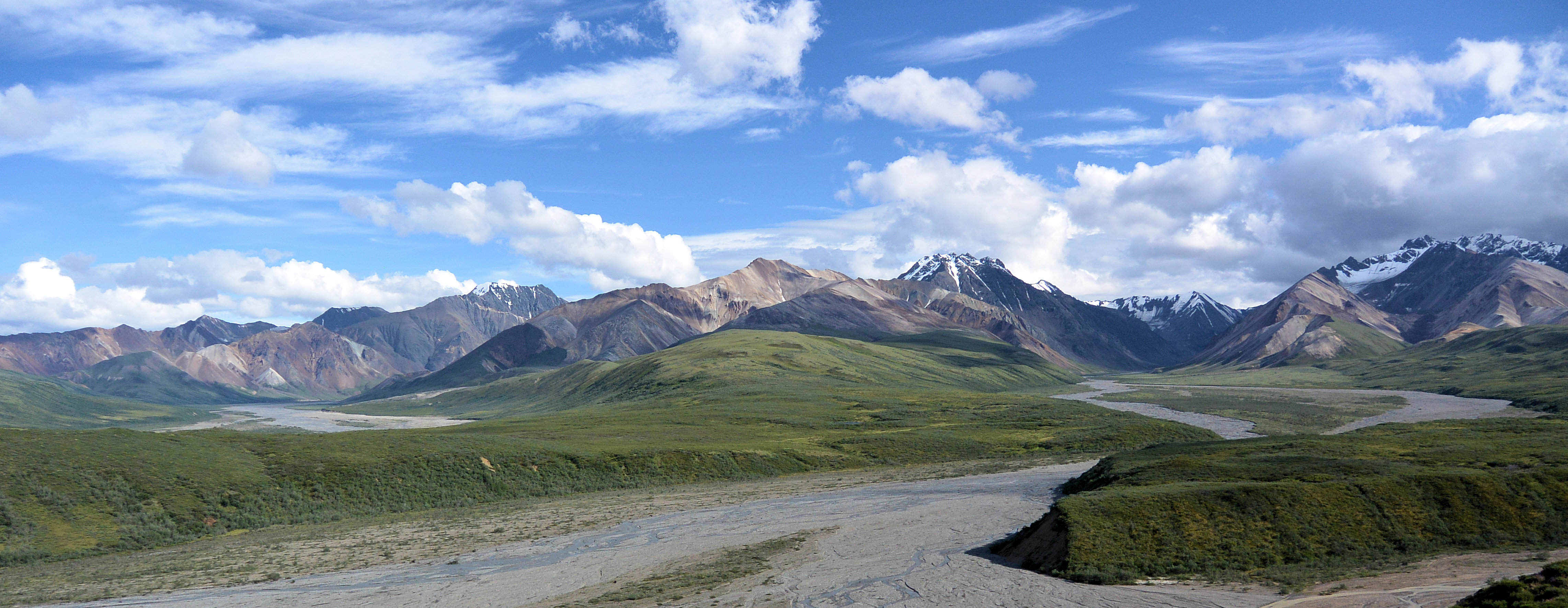
Thank you for taking we along on your adventure. I have enjoyed your posts & ,photos
We camp in a truck camper and have made several trips to Alberta. Everything you said is true!!
I have thoroughly enjoyed your posts throughout your adventure, but especially the epilogue of today. We have thought many times about taking our 40′ Tiffin Motorhome and pointing it Northwest, but based on your descriptions, I’m not sure how it would take the trip well – perhaps we’ll consider ferrying it up and doing a little adventuring after we get there.
Nevertheless, I feel that I’ve been there already just reading your vivid descriptions.
BTW, we’re on the “right” coast (North Carolina). There are some nice adventures here – and we’ve been to Calif. Beautiful Place!
Well, don’t be daunted by my dour passages. We saw a lot of BIG coaches up there. Stick to the paved highways, pull a toad for flexible explorations. No worries…
… and yes, we’d like to do some touring “back East” sometime too.